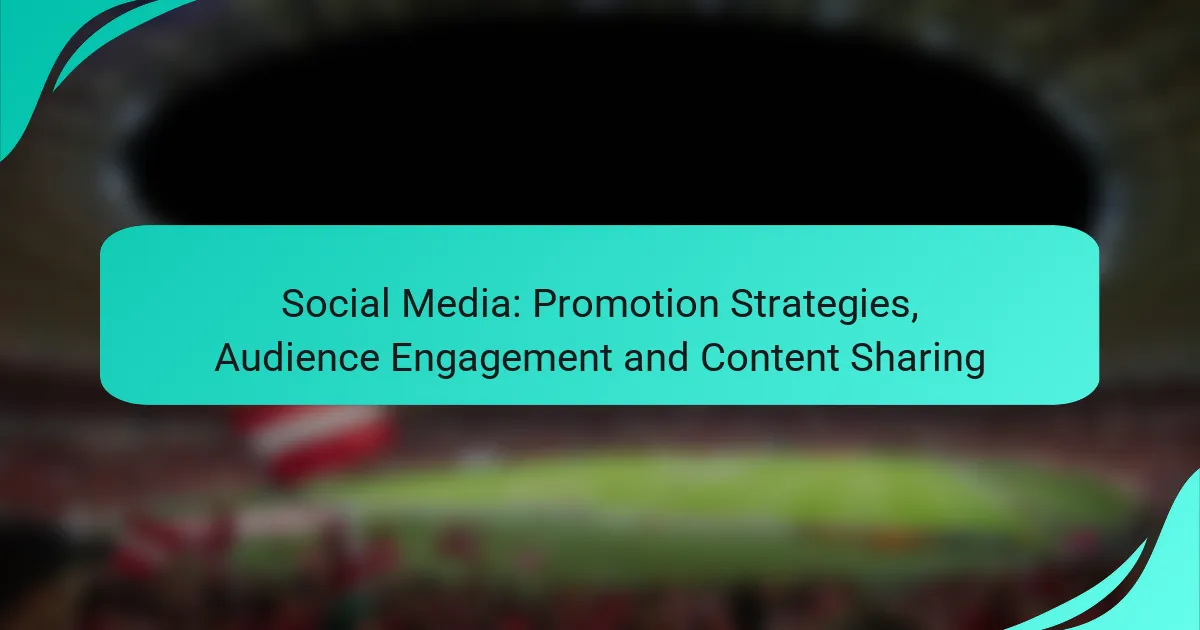In today’s digital landscape, effective social media promotion strategies are essential for brands looking to enhance their visibility and engage with audiences. By utilizing targeted advertising, influencer partnerships, and compelling content, businesses can create meaningful interactions that foster community and loyalty. Additionally, strategic content sharing practices, such as optimal timing and the use of engaging visuals, can significantly increase audience engagement and expand reach.
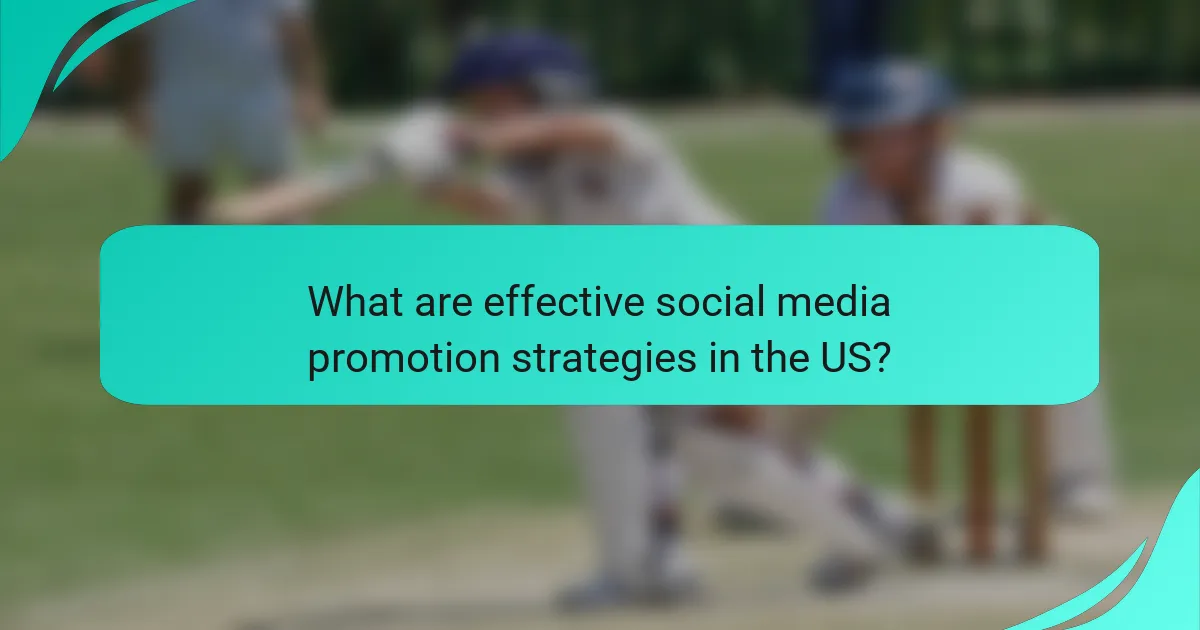
What are effective social media promotion strategies in the US?
Effective social media promotion strategies in the US include targeted advertising, influencer partnerships, content marketing, and video campaigns. These strategies leverage the unique features of each platform to engage audiences and drive conversions.
Targeted advertising on Facebook
Targeted advertising on Facebook allows businesses to reach specific demographics based on interests, behaviors, and location. By utilizing Facebook’s robust ad targeting options, brands can tailor their messages to resonate with their ideal customers.
To maximize effectiveness, consider A/B testing different ad formats and messages. Monitor key metrics such as click-through rates and conversion rates to refine your strategy over time.
Influencer partnerships on Instagram
Influencer partnerships on Instagram can significantly boost brand visibility and credibility. Collaborating with influencers who align with your brand values allows you to tap into their follower base and create authentic content that resonates.
When selecting influencers, focus on engagement rates rather than follower counts. Micro-influencers often yield higher engagement and can be more cost-effective, making them a smart choice for many brands.
Content marketing on LinkedIn
Content marketing on LinkedIn is essential for B2B companies looking to establish thought leadership and connect with professionals. Sharing articles, case studies, and industry insights can position your brand as an authority in your field.
Utilize LinkedIn’s publishing platform to share long-form content and engage with your audience through comments and discussions. Regularly posting valuable content can help grow your network and generate leads.
Video campaigns on TikTok
Video campaigns on TikTok can capture attention quickly and engage users through creative storytelling. TikTok’s algorithm favors authentic and entertaining content, making it an ideal platform for brands to showcase their personality.
Focus on creating short, engaging videos that align with trending challenges or themes. Collaborating with TikTok creators can also enhance your reach and credibility, as they understand the platform’s dynamics and audience preferences.
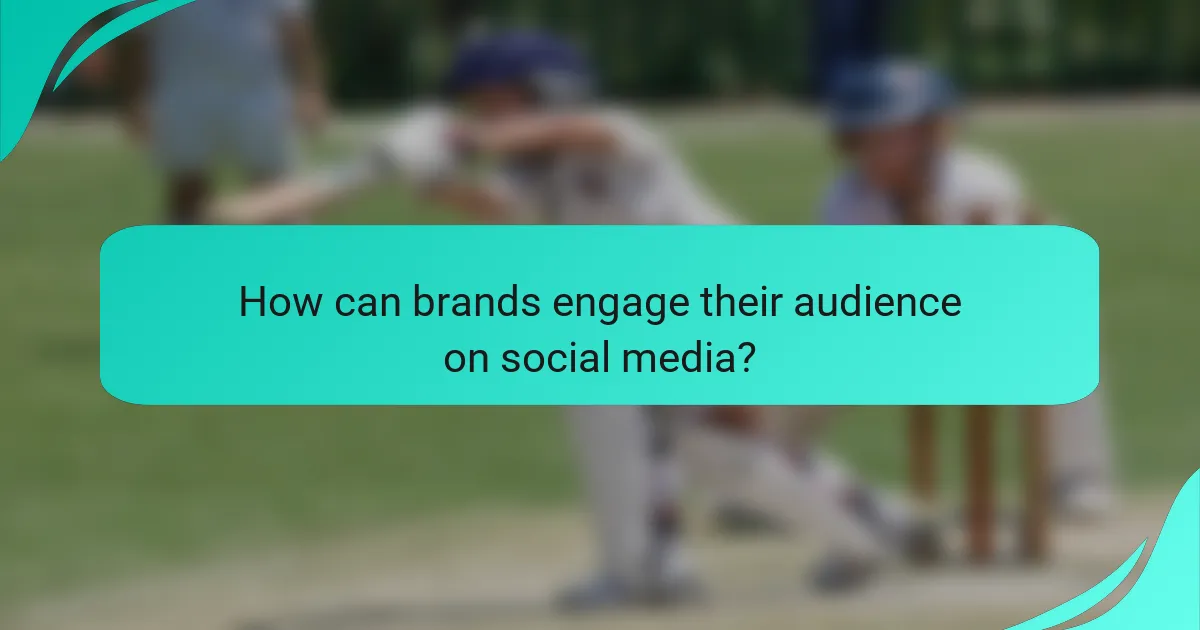
How can brands engage their audience on social media?
Brands can engage their audience on social media by creating interactive and meaningful experiences that encourage participation and feedback. This engagement fosters a sense of community and loyalty among followers, ultimately enhancing brand visibility and connection.
Interactive polls and quizzes
Interactive polls and quizzes are effective tools for engaging audiences by inviting them to share their opinions or test their knowledge. These formats can be easily shared across platforms, increasing visibility and participation. For instance, a brand might create a poll asking followers to choose their favorite product feature or a quiz related to their industry.
When designing polls and quizzes, keep questions concise and relevant to your audience’s interests. Aim for a balance between fun and informative content to maintain engagement. Consider using visuals to enhance the experience, as eye-catching designs can attract more responses.
Live Q&A sessions
Live Q&A sessions allow brands to interact directly with their audience in real-time, fostering a personal connection. These sessions can be hosted on platforms like Instagram Live or Facebook Live, where followers can ask questions and receive immediate responses. This format not only boosts engagement but also showcases the brand’s transparency and willingness to communicate.
To maximize the effectiveness of a live Q&A, promote the event in advance and encourage followers to submit questions beforehand. Ensure that the session is well-structured, with a moderator to keep the conversation flowing and address questions efficiently.
User-generated content campaigns
User-generated content campaigns invite followers to create and share their own content related to the brand, enhancing community involvement. This strategy not only provides authentic content but also encourages participants to spread the word about the brand. For example, a clothing brand might ask customers to post photos wearing their products with a specific hashtag.
To run a successful user-generated content campaign, clearly define the campaign’s goals and guidelines. Offer incentives, such as contests or features on the brand’s official page, to motivate participation. Monitor submissions to engage with users and showcase their contributions, reinforcing a sense of community.
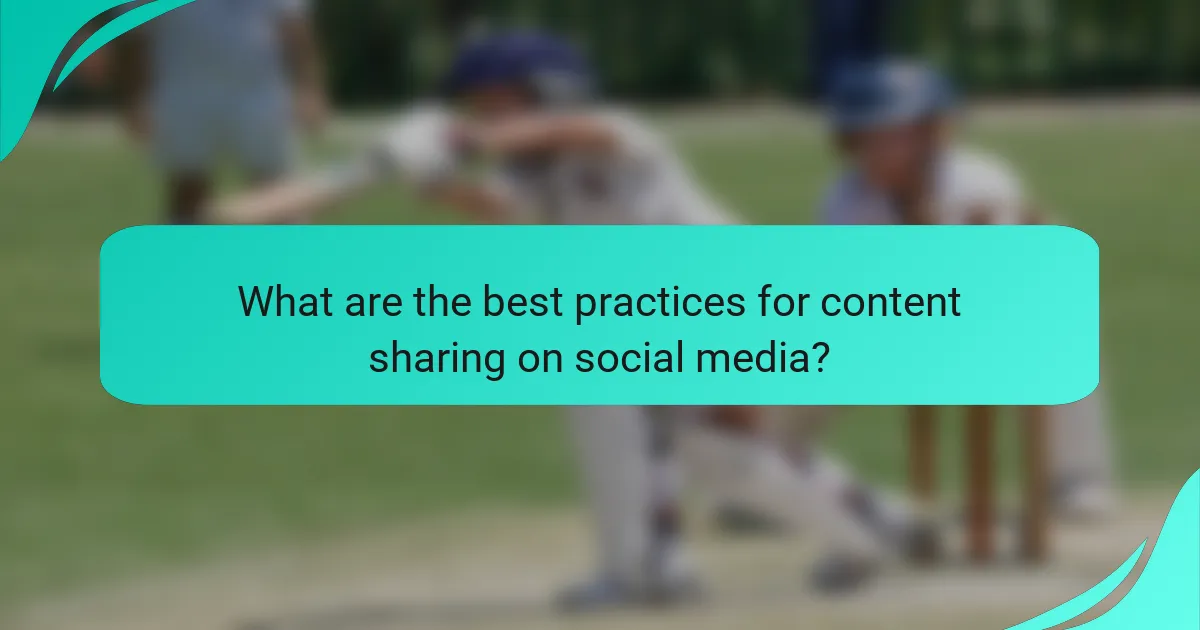
What are the best practices for content sharing on social media?
Effective content sharing on social media involves strategic timing, appropriate use of hashtags, and creating visually appealing content. These practices enhance audience engagement and increase the likelihood of shares, thereby expanding your reach.
Optimizing post timing for engagement
Timing your posts can significantly impact engagement rates. Research suggests that posting during peak hours, typically early mornings and late afternoons on weekdays, can lead to higher visibility and interaction.
Consider using social media analytics tools to identify when your audience is most active. Adjust your posting schedule accordingly to align with these peak times for maximum engagement.
Using hashtags effectively
Hashtags categorize content and make it discoverable. Using relevant and trending hashtags can increase the chances of your posts being seen by a broader audience.
Limit the number of hashtags to around three to five per post to avoid overwhelming your audience. Additionally, research hashtags specific to your industry or region to enhance relevance and engagement.
Creating shareable visuals
Visual content is more likely to be shared than text-only posts. Invest in high-quality images, infographics, or videos that resonate with your target audience.
Ensure your visuals are optimized for each platform’s specifications, such as dimensions and file size. Engaging visuals should also include clear branding and a call-to-action to encourage sharing.
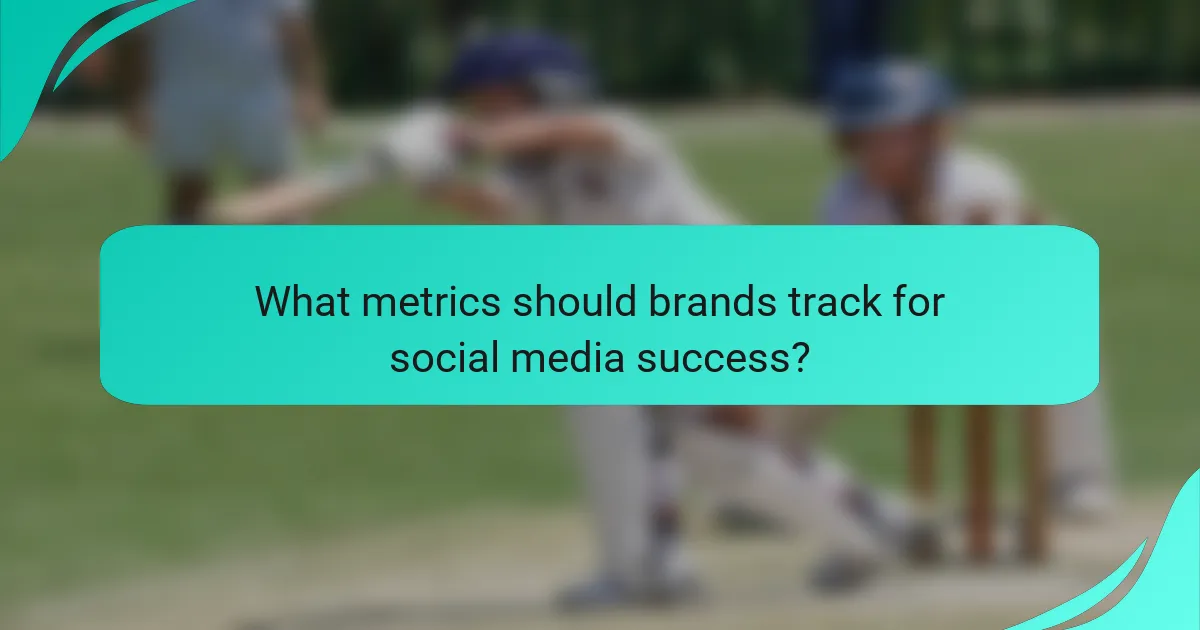
What metrics should brands track for social media success?
Brands should track key metrics such as engagement rate, click-through rate, and conversion rate to measure their social media success. These metrics provide insights into audience interaction, content effectiveness, and overall return on investment.
Engagement rate
Engagement rate measures how actively users interact with your content, including likes, shares, comments, and reactions. A higher engagement rate indicates that your audience finds your content relevant and compelling.
To calculate engagement rate, divide the total engagement actions by the total number of followers or impressions, then multiply by 100 to get a percentage. Aim for an engagement rate of around 1-5% for most platforms, but this can vary by industry.
Common pitfalls include focusing solely on follower count rather than engagement. Prioritize creating quality content that resonates with your audience to boost this metric.
Click-through rate
Click-through rate (CTR) measures the percentage of users who click on a link in your post compared to the total number of users who viewed it. A higher CTR indicates effective calls to action and relevant content.
To calculate CTR, divide the number of clicks by the number of impressions and multiply by 100. A good CTR typically ranges from 2-5%, but this can differ based on the platform and industry standards.
To improve CTR, use compelling headlines, clear calls to action, and visually appealing content. Avoid misleading links, as they can harm your brand’s credibility and reduce future engagement.
Conversion rate
Conversion rate tracks the percentage of users who complete a desired action, such as making a purchase or signing up for a newsletter, after interacting with your social media content. This metric is crucial for assessing the effectiveness of your social media campaigns in driving business goals.
To calculate conversion rate, divide the number of conversions by the total number of visitors from social media, then multiply by 100. A typical conversion rate can vary widely, often falling between 1-10% depending on the industry and the specific action taken.
To enhance conversion rates, ensure your landing pages are optimized for user experience and relevant to the content shared. Avoid overwhelming users with too many options, as this can lead to decision fatigue and lower conversions.
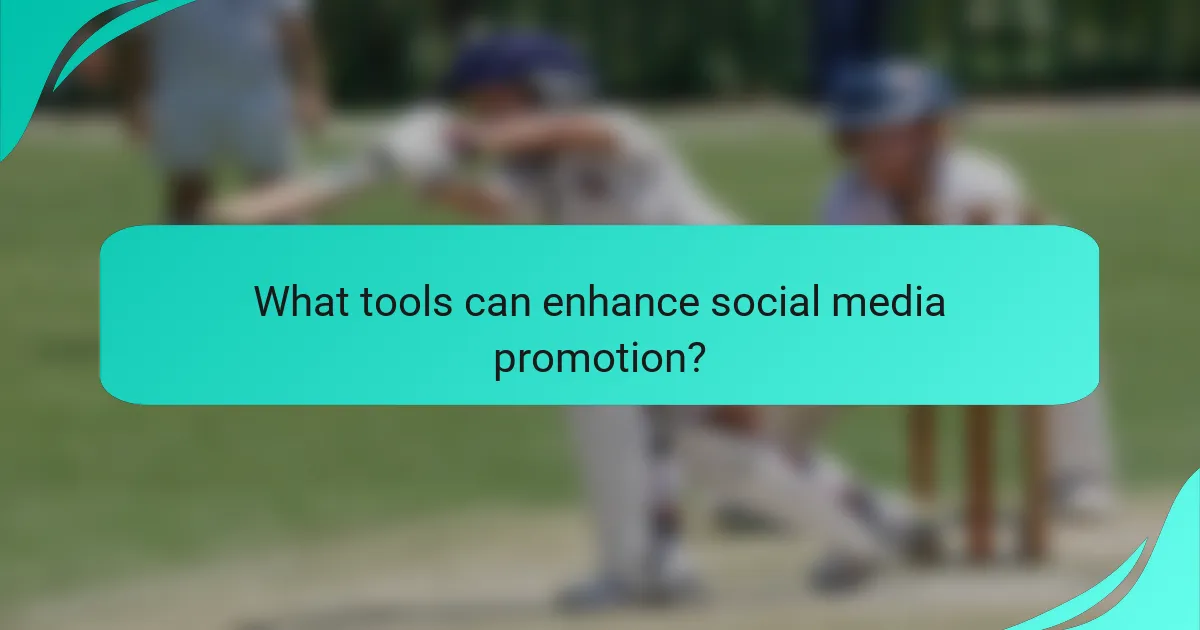
What tools can enhance social media promotion?
Several tools can significantly improve social media promotion by streamlining scheduling, enhancing graphic design, and optimizing content sharing. Utilizing the right tools can save time and increase engagement with your audience.
Hootsuite for scheduling
Hootsuite is a powerful tool for scheduling social media posts across multiple platforms. It allows users to plan content in advance, ensuring a consistent online presence without the need for constant manual updates.
When using Hootsuite, consider the best times to post based on your audience’s activity. This can vary by platform and demographic, so monitoring engagement metrics is crucial. Aim to schedule posts during peak engagement hours, which often fall in the late morning or early evening.
To maximize effectiveness, utilize Hootsuite’s analytics features to track post performance. Adjust your strategy based on what types of content resonate most with your audience, whether it’s images, videos, or links.
Canva for graphic design
Canva is an intuitive graphic design tool that helps create visually appealing content for social media. It offers a wide range of templates tailored for different platforms, making it easy to produce professional-quality graphics quickly.
When designing with Canva, focus on maintaining brand consistency through colors, fonts, and logos. This helps in building brand recognition and trust among your audience. Utilize Canva’s collaboration features to work with team members, ensuring that everyone can contribute to the design process.
For effective social media graphics, aim for high-quality images that are optimized for each platform’s specifications. For instance, Instagram favors square images, while Facebook often uses landscape formats. Always check the latest guidelines to ensure your content displays correctly.
